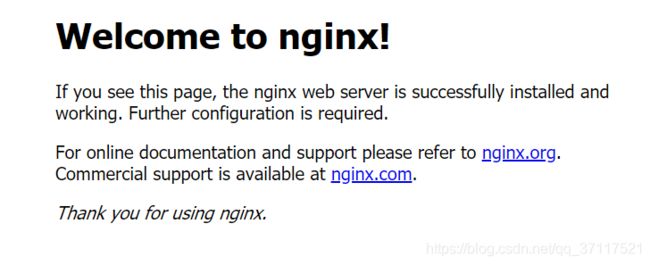Linux(centos7)+Nginx+MySQL+PHP服务器部署教程
安装Nginx
//使用yum安装nginx
# yum install nginx
//如果报No package nginx available错误。
//启动nginx
# systemctl start nginx
//设置开机自启动
# systemctl enable nginx
//防火墙设置开启80端口
#systemctl start firewalld
//如果报Failed to start firewalld.service: Unit is masked.错误。
# firewall-cmd --permanent --zone=public --add-service=http
# firewall-cmd --zone=public --add-port=80/tcp --permanent
success
安装MySQL
# yum install mariadb mariadb-server mariadb-libs mariadb-devel
# rpm -qa |grep maria
mariadb-libs-5.5.52-1.el7.i686
mariadb-5.5.52-1.el7.i686
mariadb-server-5.5.52-1.el7.i686
mariadb-devel-5.5.52-1.el7.i686
//开启MySQL服务,并设置开机启动,检查MySQL状态
# systemctl start mariadb
# systemctl enable mariadb
# netstat -tulp (先安装yum install net-tools)
//数据库安全设置
# mysql_secure_installation
NOTE: RUNNING ALL PARTS OF THIS SCRIPT IS RECOMMENDED FOR ALL MariaDB
SERVERS IN PRODUCTION USE! PLEASE READ EACH STEP CAREFULLY!
In order to log into MariaDB to secure it, we'll need the current
password for the root user. If you've just installed MariaDB, and
you haven't set the root password yet, the password will be blank,
so you should just press enter here.
Enter current password for root (enter for none):
OK, successfully used password, moving on...
Setting the root password ensures that nobody can log into the MariaDB
root user without the proper authorisation.
Set root password? [Y/n] y
New password:
Re-enter new password:
Password updated successfully!
Reloading privilege tables..
... Success!
By default, a MariaDB installation has an anonymous user, allowing anyone
to log into MariaDB without having to have a user account created for
them. This is intended only for testing, and to make the installation
go a bit smoother. You should remove them before moving into a
production environment.
Remove anonymous users? [Y/n] y
... Success!
Normally, root should only be allowed to connect from 'localhost'. This
ensures that someone cannot guess at the root password from the network.
Disallow root login remotely? [Y/n] n
... skipping.
By default, MariaDB comes with a database named 'test' that anyone can
access. This is also intended only for testing, and should be removed
before moving into a production environment.
Remove test database and access to it? [Y/n] y
- Dropping test database...
... Success!
- Removing privileges on test database...
... Success!
Reloading the privilege tables will ensure that all changes made so far
will take effect immediately.
Reload privilege tables now? [Y/n] y
... Success!
Cleaning up...
All done! If you've completed all of the above steps, your MariaDB
installation should now be secure.
Thanks for using MariaDB!
//登录数据库测试
# mysql -u root -p
MariaDB [(none)]> show databases;
+--------------------+
| Database |
+--------------------+
| information_schema |
| mysql |
| performance_schema |
+--------------------+
3 rows in set (0.02 sec)
MariaDB [(none)]>
quit或者exit退出mysql。
安装PHP
# yum -y install php
# rpm -ql php
/etc/httpd/conf.d/php.conf
/etc/httpd/conf.modules.d/10-php.conf
/usr/lib/httpd/modules/libphp5.so
/usr/share/httpd/icons/php.gif
/var/lib/php/session
//将PHP与MySQL关联起来
# yum install php-mysql
# rpm -ql php-mysql
/etc/php.d/mysql.ini
/etc/php.d/mysqli.ini
/etc/php.d/pdo_mysql.ini
/usr/lib/php/modules/mysql.so
/usr/lib/php/modules/mysqli.so
/usr/lib/php/modules/pdo_mysql.so
//安装常用PHP模块
# yum install -y php-gd php-ldap php-odbc php-pear php-xml php-xmlrpc php-mbstring php-snmp php-soap curl curl-devel php-bcmath
//测试PHP
# cd /usr/share/nginx/html
# ls
# pwd
/usr/share/nginx/html
# vi info.php
phpinfo();
?>
~
~
~
~
~
~
~
~
:wq
//重启nginx服务器
# systemctl restart nginx
//测试PHP
# yum -y install php-fpm
#systemctl start php-fpm
# systemctl enable php-fpm
在自己电脑浏览器输入xxx.xxx.xx.xx(服务器ip),你可以看到nginx欢迎页;
出现自动下载PHP页面情况需要在/etc/nginx/nginx.conf文件中增加sever配置
#默认80端口 IP访问
server {
listen 80 default_server;
listen [::]:80 default_server;
server_name _;
root /usr/share/nginx/html;
# Load configuration files for the default server block.
include /etc/nginx/default.d/*.conf;
location / {
#定义首页索引文件的名称
index index.php index.html index.htm;
}
#PHP 脚本请求全部转发到 FastCGI 处理,使用FastCGI 默认设置
location ~ .php$ {
fastcgi_pass 127.0.0.1:9000;
fastcgi_index index.php;
fastcgi_param SCRIPT_FILENAME $document_root$fastcgi_script_name;
include fastcgi_params;
}
error_page 404 /404.html;
location = /40x.html {
}
error_page 500 502 503 504 /50x.html;
location = /50x.html {
}
}
在自己电脑浏览器输入xxx.xxx.xx.xx(服务器ip)/info.php,你可以看到已经安装的模块;
//数据库开启远程访问
mysql -u root -p
use mysql;
GRANT ALL PRIVILEGES ON *.* TO 'root'@'%'IDENTIFIED BY 'root' WITH GRANT OPTION;
//推送设置到内存或重启服务器也行
FLUSH PRIVILEGES;

